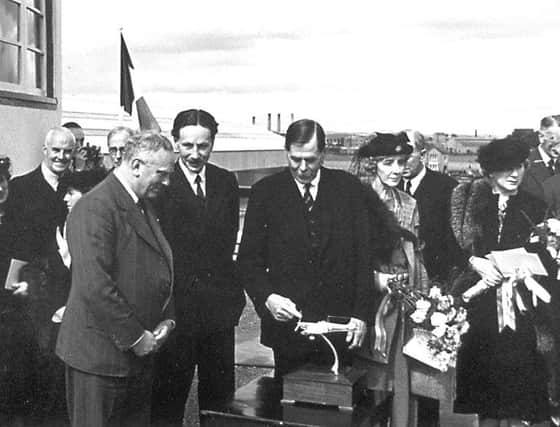Port was flying high as age of aviation dawned


Although it was the culmination of several years of planning, it was not until February 1939 that Scottish Aviation Limited announced plans to provide central Scotland with what would be the largest airport in the country.
Five hundred acres of farm land were purchased in the Grangemouth area by the firm which had secured a Government contract to train pilots in preparation for the war that everyone seemed to expect.
Advertisement
Hide AdAdvertisement
Hide AdThey had also decided that there was a real opportunity to develop a commercial airport serving both Glasgow and Edinburgh and, within two months of starting work, the new grass runways were in use for a commercial flight on the Shetland to London route. The first ticket was sold to Provost R. Bruce Peddie for £9 10 shillings and he flew south in a six-seater de Havilland Dragon Rapide.
By June the airport was almost ready with 2000 feet of runway, a fine terminal building, a control tower and two large hangers.
It cost £160,000 and on July 1 Lord Trenchard turned the propeller of a model Spitfire to signify that the aerodrome was in business.
To underline the importance of the new venture one VIP visitor on the day was the chairman of KLM Royal Dutch Airlines, Albert Plesman, who arrived in a Douglas DC3, the most advanced passenger plane in the world at the time.
Advertisement
Hide AdAdvertisement
Hide AdHis company wanted to include a stop at Grangemouth as part of its scheduled service when things were fully up and running but the outbreak of war a few months later changed everything.
The airport’s commercial activities came to an abrupt end as the military took over.
Grangemouth was designated as a base for fighter aircraft given the task of defending against enemy bombers aiming for our local iron works and dockyards.
When the fear of such bombing raids declined at the end of 1940, Grangemouth became a training centre where young pilots were introduced to the Spitfire and taught the skills of formation flying and gunnery and it remained in this role until near the end of the war.
Advertisement
Hide AdAdvertisement
Hide AdOver 60 young men, from Britain and all parts of the Commonwealth, as well as Poland and Czechoslovakia, died while learning the daring manoeuvres demanded in those incredible times.
In all, nearly 80 air and ground crew lost their lives while serving at Grangemouth and many are buried in a special section of Grandsable Cemetery.
With the peace came a change of heart and the ambitious plans were abandoned as was the airfield. In 1955 it was closed to flying altogether and its runways provided practice ground for learner drivers and courting couples.
By the 1960s it was being ripped up and gradually filled with streets, houses, warehouses and factories. The hangers survive but that’s about all.
Advertisement
Hide AdAdvertisement
Hide AdBut the service and sacrifice of those who came here has never been forgotten by 1333 Grangemouth (Spitfire) Squadron Air Training Corps and with the help of a trust and the financial and moral support of the people of the district the magnificent replica Spitfire was erected on Bo’ness Road in 2013 close to the surviving hangers.
It stands as a reminder to the present generation and those still to come that the land surrounding the memorial once thronged with young men and women and hummed with the sound of propellers turning and engines roaring as they prepared to defend the liberty which we all take for granted today.